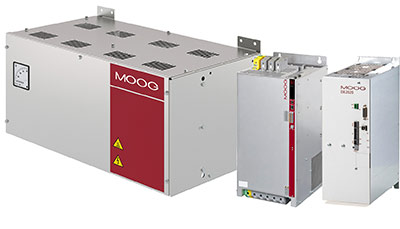Moog Inc. announced a new Energy Management System (EMS) for machines with electrohydrostatic actuation systems.
 In the machine manufacturing industry, more and more drive systems are being converted from the servo-hydraulic throttle principle to electrohydrostatic actuation systems (EAS). The 4-quadrant capability of the electrohydrostatic pump unit and servo drive used in this technology, in combination with the new Moog Energy Management System (EMS), allows regenerative power flows generated during braking or pressure relief to be stored and reused.
In the machine manufacturing industry, more and more drive systems are being converted from the servo-hydraulic throttle principle to electrohydrostatic actuation systems (EAS). The 4-quadrant capability of the electrohydrostatic pump unit and servo drive used in this technology, in combination with the new Moog Energy Management System (EMS), allows regenerative power flows generated during braking or pressure relief to be stored and reused.
The Moog EMS, consisting of power supply and energy storage (ESU-C Storage Unit), also supports machine builders in the important goal of reducing the connected load in the EAS-based machine concept to a fraction of the peak power compared to the hydraulic concept by using actively or passively operating capacitors and/or kinetic storage.
Oscillating applications such as elastic material testing or gas compressors and pressure intensifiers, where very high positive and negative power peaks occur and low process energies are required, are ideal use cases for the Moog EMS. These peak shaving approaches also make sense for forming presses, injection moulding machines and hexapods.
In customer applications in testing and forming technology, the use of the Moog EMS has enabled the maximum power consumption from the power grid to be reduced by a factor of six in some cases.
Moog Inc.
www.moog.com
Filed Under: Components Oil Coolers, Pumps & Motors